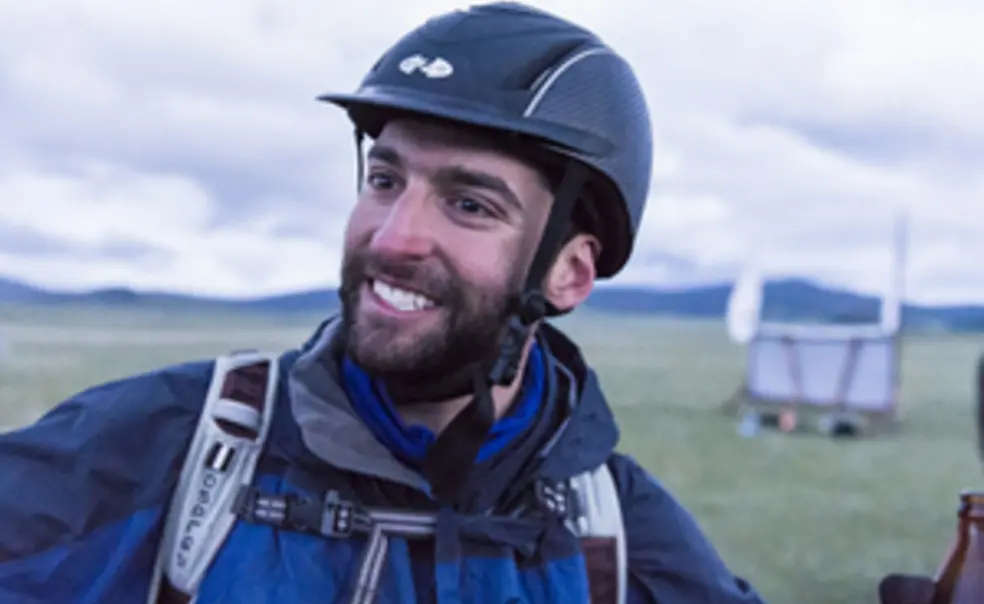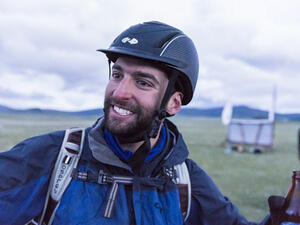Tiger of the Week: George Azarias '07
George Azarias '07 at the finish line of the Mongol Derby. (Photo: Richard Dunwoody/The Adventurists)
As an undergraduate, George Azarias ’07 wanted to become a leader for Outdoor Action, Princeton’s popular outdoor education program, but the last leader-training trip of the year conflicted with the final exam in an economics course he was taking. So Azarias lobbied to arrange an on-the-trail final, administered in a park ranger station. He earned passing grades in both the course and the leader training, and afterward, he says, his connection to the outdoors “blossomed,” largely because of OA.
Five years after graduation, Azasias credits OA director Rick Curtis ’79 and naturalist Robert Peck ’74 with inspiring his latest adventure: the Mongol Derby, a relay through Mongolia that holds the Guinness World Record for longest horse race, covering more than 600 miles.
Curtis invited Peck to speak at a Reunions event in 2009 and share experiences from several trips to Mongolia, and the talk set Azarias searching for a way to see the breathtaking steppes he’d seen in Peck’s photos. A veteran of adventure racing, Azarias had already completed the Iditarod Trail Invitational, in which competitors traverse 350 miles of Alaskan wilderness in the dead of winter.
Azarias, a derivatives trader in Sydney, Australia, applied for the Mongol Derby and was selected, despite being a relative novice on horseback (others in the field included professional riders and experienced ranchers). He trained on weekends, hoping to prepare for the “semi-wild” horses of the derby, which he says were “more like 3/4 wild or 9/10 wild.”
Switching horses every 25 miles, the riders are constantly trying to establish trust with new mounts, coaxing, coaching, and in Azarias’ case, singing to keep them calm. (“That actually worked really well,” he says.) At dusk on the second day of the race, Azarias had a near catastrophe while riding and trying to dig his headlamp from his backpack. Alarmed by the rustling, the horse began to spin, sending Azarias to the ground. He lost hold of the reins, and the horse ran off, taking with it Ararias’ sleeping bag.
Azarias was able to cobble together supplies and continue the race. Later, his OA training proved helpful when he stopped to assist another rider who had been thrown from his horse and injured. Despite the delays and mishaps, Azarias crossed the finish line after nine days of riding, completing one of the world’s most challenging races.
UPDATE: PAW’s interview with Azarias, conducted via Skype Aug. 28, was cut short due to scheduling constraints, but in a follow-up message he explained the injury that occurred late in the race. A fellow rider was bucked off his horse, breaking his nose and fracturing the base of his spine. Azarias and a third rider immobilized the injured rider’s spine and stayed with him until medics arrived. “Because I was already at the tail end of the riders when the incident happened, and I lost an additional six hours, they moved me up two horse stations by car,” Azarias said. “This officially disqualified me. But I finished most of the rest of the race on horseback.”
Do you have a nominee for Tiger of the Week? Let us know. All alumni qualify. PAW’s Tiger of the Week is selected by our staff, with help from readers like you.














No responses yet